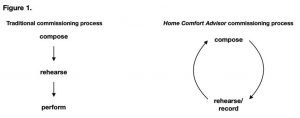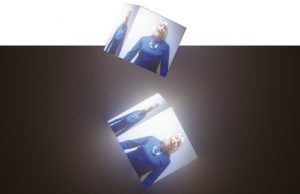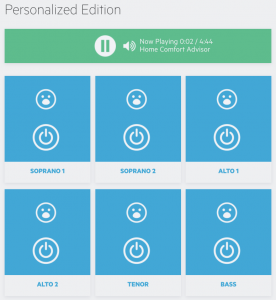Machine Learning and Computer Graphics meet Polyphonic Choral Music in Home Comfort Advisor by Eliot Britton and the Amadeus Choir
Kathleen Allan, Artistic Director and Conductor, Amadeus Choir of Greater Toronto, Canada
A new challenge
In the spring of 2020, choirs were presented with the biggest challenge in the history of our practice: how do we make choral music without being in the same room?
In response to this challenge, myriad innovations came flooding into the digital choral space. From grids of floating faces to live-streamed, socially-distanced concerts, choirs were proving what most of us already suspected: that nothing, not even a global pandemic, could keep us from making music together.
The Amadeus Choir is a semi-professional choir of approximately 70 voices that regularly commissions and performs new work, especially by Canadian composers. However, aside from its artistic endeavours, the choir is also a tightly-knit community established over its 47 years of history. Keeping the choir connected socially and maintaining the joy of singing were vital during this period of isolation, as was upholding our mandate of presenting new work.
A new format
When I approached composer/media-artist Eliot Britton about creating a piece for the Amadeus Choir to perform remotely, we discussed wanting to break the mold that had quickly become the dominant “virtual choir” format. He suggested that his artist collective, Quigital, take on the project. Consisting of a composer, a lyricist, a graphic designer, and a software engineer, all with connections to choral music, the team was perfectly equipped to create a work of digital choral art for the pandemic age.
Quigital is a group of artists that explores the absurdity of corporate aesthetics and culture through interactive art. “It is largely about exploring the creepy side of machine learning and data collecting, and then showing how affably it’s presented to the public,” says Eliot Britton. With slick, corporate visuals, innovative technological approaches, and engaging interactive components, Quigital highlights and critiques the relationship between corporations and their consumers. “There’s something that’s very comforting and familiar about the corporate branding aesthetic, but then under the surface, it’s actually quite disturbing and ominous. The project is actually a subversive critique of capitalism and big data.”
As the pandemic raged on and the digital takeover of the domestic sphere accelerated more, the Quigital concept seemed to be the perfect vehicle to keep our singers connected and create a meaningful artistic project with a light-hearted approach. So, the team began the months-long creation of a satirical, interactive, musical web experience called “Home Comfort Advisor: Your new, choral smart home.”
A new process
Since early in the pandemic, we, like so many choirs, had experienced the frustration that came with trying to simulate group singing over the Internet. Whether by attempting to rehearse over Zoom, or by editing dozens of video and audio files together, it was impossible to achieve the musical magic so easily achieved with a single breath drawn together in the same room. “I want to do something that moves in a different direction and really embraces what a choir can be on the Internet in the 21st century,” says composer Eliot Britton. “How can we make this interactive for the audience?”
The chorister experience was also at the forefront of the project’s design. “I was thinking of all the excited, community-driven choir people who were in their own individual homes,” says Britton. “And I thought, how can this be interesting for each person? So, baked into the whole process of this work was the assumption that every single person is going to be recording in an unknown room with an unknown microphone with an unknown level of audio quality.”

Rather than the traditional commissioning process of compose -> rehearse -> perform, the relationship between choir and composer was to be more reciprocal (See Figure 1). In a collaboration that spanned the entire season, Britton would provide small fragments to the choir, sometimes attending a rehearsal to describe his ideas and coach the recording process. Then, singers would upload their recordings for Britton and his team to manipulate and assemble into the final electronic compositions and interactive online content.
For the elements that were to be musically synchronized, even the guide tracks used for recording were in keeping with the Quigital aesthetic. Highly produced and using a corporate-sounding voiceover, the choir would be led through the track (“Now it’s time for my favourite: Rehearsal ‘C’!”), given their pitch, and even complimented on their take: “Wow – That was incredible!”
Hear an example guide track here: http://bit.ly/quigitalclick1.
The new creation
The final work consists of four movements (five if you count the “Help” section), all of which are housed on the custom website quigital.com/smarthome. Three promotional trailers for the project (that look like advertisements for the fake Quigital smart home products) are considered “Movement zero” and can be viewed on the Amadeus Choir’s YouTube channel.
Movement I uses text generated by “Quigital_AI,” the machine learning system programmed to spit out quasi-intelligible (and rhyming) text fragments based on 10,000 pages of smart home manuals.
The music was inspired by a French Renaissance chanson, “Belle qui tiens ma vie” by Jehan Tabourot. Because of the experimental nature of the project, Britton wanted to start out with a musical aesthetic that was very accessible. “Having something familiar that is underneath something extremely strange makes it more digestible. It allows the audience who’s interacting with it to see more patterns.”
Random combinations of Amadeus voices are presented by pressing the button, “See next models,” to create a seemingly infinite number of ways to enjoy this quirky start to the piece.
II. Home Comfort Advisor
Quigital_AI’s smart home text is set in an original six-voice motet by Eliot Britton in this movement which uses the three-note Quigital corporate theme as the musical seed for a nearly five-minute work. The “relaxing imitative polyphonic style” is customizable according to the listener’s preferred voicing. Listeners can turn each of the six voice parts (SSAATB) off and on as the piece plays. Again, a familiar musical aesthetic is used to deliver an absurd faux-corporate message, though now with original music. “I went all out with every shred of Renaissance polyphonic compositional power that I could muster. That brings us to the idea of skirting authenticity. If it wasn’t beautiful, then it wouldn’t work.”
III. Exit Time Into Schedule
A purely audio experience, this movement takes a complete turn into techno-choral melancholy. “Feeling disconnected? Is digital stress causing you to check the status of the status of your smart plug?,” the website asks. Three soloists take on the roles of “Melancholy Robot Voice”, “Ominous Voice of the Future”, and “Corporate Neutral” to deliver this 2.5-minute robo-chorus.
“What I realized through this project is that we had to commit and go way beyond something that was ‘advisable’ and ‘normal’ to create something that was truly interesting,” says Britton.
“In the end, it had to be fully committed to this idea of a corporate aesthetic choir piece on the Internet.”
 V. Get Help (yes, number V comes first!)
V. Get Help (yes, number V comes first!)
At any point during a visit to the website, audience members can press “Get Help” and enjoy the tongue-in-cheek help videos by members of the Amadeus Choir, processed for extra effect by the Quigital Team. The glitchy suggestions of “you’re muted” and “I can see you but… but… but I can’t hear you” offer unlimited comic relief.
IV. Your Smart Home
When I saw the fourth movement, essentially a CGI music video, I was in awe of what Britton and his team had created. It somehow summed up all of the emotions our choir had felt over the course of a full year in lockdown. Seeing the video graphics weave through a sea of synchronized music playback devices, a brief respite in nature with the presence of the bizarre fake Quigital camera product, and finally, the singers’ faces reflected in the computer graphic sky, was overwhelming, and I couldn’t quite place why.
I think it was the way it depicted the simultaneous digital disconnect, techno overload, and yet connectedness we were all feeling. It takes the concept of “surreal” — the word I personally felt best embodies the entire pandemic experience — to the extreme, blurring the lines between digital renderings of reality and reality itself; corporate emotional manipulation and authentic emotional expression.
We have not met in person as a choir since March of 2020, but our membership and audience engagement is as strong as ever. It has been projects like this that have enabled us to make art while staying apart. And while we cannot wait to experience the magic of that group breath — that upbeat that holds so much musical potential in it — together again, we are grateful for the wild and wonderful opportunity to work with Britton and his colleagues.
You can experience Home Comfort Advisor at www.quigital.com/smarthome. Quigital is Dave Arbez, Eliot Britton, Patrick Hart, and Kevin McPhillips.
Edited by Ellen Murname, UK
KATHLEEN ALLAN is the Artistic Director of the Amadeus Choir of Greater Toronto and Artistic Director of Canzona, Winnipeg’s professional Baroque choir. Ms. Allan is in high demand as a conductor and composer and is equally comfortable working in early, contemporary, and symphonic repertoire. Originally from St. John’s, NL, she has conducted orchestras and choirs across Canada, the US, and Japan, and recently made her conducting debut with the Vancouver Symphony Orchestra (2019) and Newfoundland Symphony Orchestra (2020). She was the 2016 recipient of the Sir Ernest MacMillan Prize. She is the Co-Artistic Director of Arkora, an ensemble that blurs the lines between the music of our time and masterworks from the ancient repertoire. Her compositions have been commissioned, performed and recorded by ensembles throughout the Americas and Europe. She holds a composition degree from UBC and a master’s degree in conducting from Yale University.
About the AMADEUS CHOIR OF GREATER TORONTO: Enlivening Toronto’s arts community for 48 years, the award-winning Amadeus Choir is a semi-professional choir of auditioned voices from Toronto and the surrounding areas. The Choir champions the best of choral music and premiers works of Canadian and international composers through a self-produced Toronto concert series, guest performances, and special events. Known well beyond Toronto through tours, festivals, recordings, and national and international radio broadcasts, the Choir collaborates with many professional performing arts organizations in the GTA. The Amadeus Choir is proud to take a leading role in educating the next generation of choral musicians by providing workshops for conductors, composers, singers, and students. The Choir is known for its strong support of Canadian music, and regularly commissions work from established and emerging Canadian composers. In 2019, after celebrating the 35-year leadership of Lydia Adams, the Choir welcomed Kathleen Allan as Artistic Director and Conductor. https://www.amadeuschoir.com





